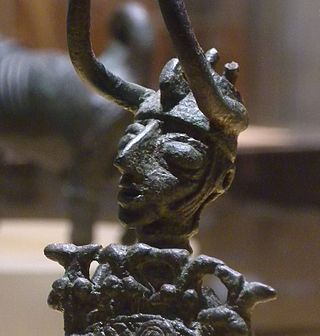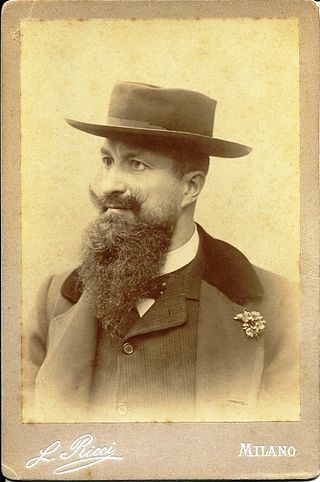
EUR is a residential and business district in Rome, Italy, part of the Municipio IX.

The Vatican Museums are the public museums of Vatican City, enclave of Rome. They display works from the immense collection amassed by the Catholic Church and the papacy throughout the centuries, including several of the most well-known Roman sculptures and most important masterpieces of Renaissance art in the world. The museums contain roughly 70,000 works, of which 20,000 are on display, and currently employ 640 people who work in 40 different administrative, scholarly, and restoration departments.
National Museum of Prehistory may refer to:

Terramare, terramara, or terremare is a technology complex mainly of the central Po valley, in Emilia, Northern Italy, dating to the Middle and Late Bronze Age c. 1700–1150 BC. It takes its name from the "black earth" residue of settlement mounds. Terramare is from terra marna, "marl-earth", where marl is a lacustrine deposit. It may be any color but in agricultural lands it is most typically black, giving rise to the "black earth" identification of it. The population of the terramare sites is called the terramaricoli. The sites were excavated exhaustively in 1860–1910.

The Galleria Nazionale d'Arte Moderna e Contemporanea, also known as La Galleria Nazionale, is an art museum in Rome. It was founded in 1883 on the initiative of the then minister Guido Baccelli and is dedicated to modern and contemporary art.

Rome's National Museum of Oriental Art "Giuseppe Tucci" is a museum in Rome, Italy, that was dedicated to the arts of the Orient, from the Middle East to Japan. The museum was located in Via Merulana 248 in the Rione Esquilino.

Luigi Pigorini was an Italian palaeoethnologist, archaeologist and ethnographer.
Carlo Anti was an archaeologist and an officer in the army in the First World War and until 1922.

MAXXI is a national museum of contemporary art and architecture in the Flaminio neighborhood of Rome, Italy. The museum is managed by a foundation created by the Italian ministry of cultural heritage. The building was designed by Zaha Hadid, and won the Stirling Prize of the Royal Institute of British Architects in 2010.
The Venus of Savignano is a Venus figurine made from soft greenstone (serpentine) dating back to the Upper Paleolithic, which was discovered in 1925 near Savignano sul Panaro in the Province of Modena, Italy.

The Polo Museale del Lazio is an office of Italy's Ministry of Cultural Heritage. Its seat is in Rome in the Palazzo Venezia.

The Nuragic bronze statuettes are typical Nuragic Sardinian bronze sculptures of the final phase of the Bronze Age and the early Iron Age.

The Arene Candide, is an archaeological site in Finale Ligure, Liguria, Italy. Its name was derived from the eponymous dune of white (candida) sand (arena) that could be found at the base of the cliff until the 1920s in the Caprazoppa promontory, where the Arene Candide cave is located.

Luigi Robecchi Bricchetti was an Italian explorer, geographer, cartographer and naturalist.
The Istituto superiore regionale etnografico is an institution based in Nuoro (Sardinia), established in 1972 by the Regional Council of Sardinia.

The Basilio Cascella Civic Museum is an Italian pinacotheca based in Pescara in the Porta Nuova district. The museum is located in the former lithographic establishment established at the end of the nineteenth century by the painter Basilio Cascella. The building, for half a century the center of artistic production and meeting place for intellectuals such as Gabriele D'Annunzio, Luigi Pirandello, and Giovanni Pascoli, was donated to the Comune of Pescara in 1966 by the heirs of Cascella.

The Kircherian Museum was a public collection of antiquities and artifacts, a cabinet of curiosities, founded in 1651 by the Jesuit father Athanasius Kircher in the Roman College. Considered the first museum in the world, its collections were gradually dispersed over the centuries under different curatorships. After the Unification of Italy, the museum was dissolved in 1916 and its collection was granted to various other Roman and regional museums.














